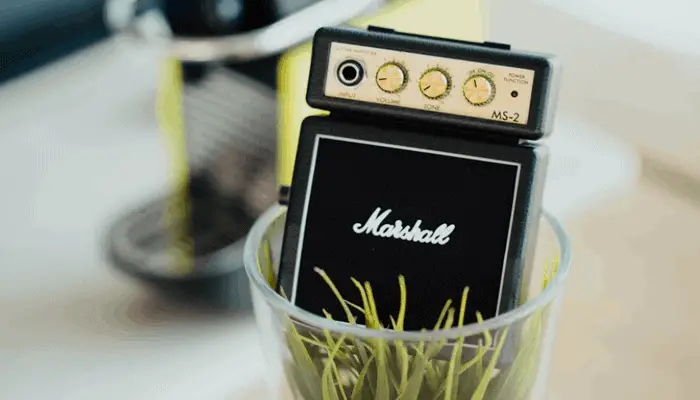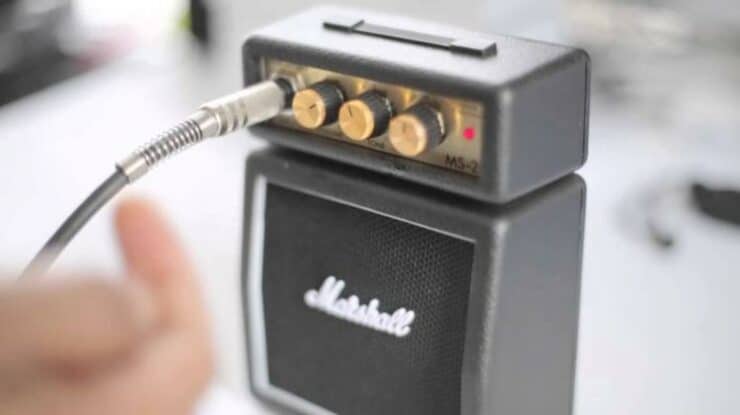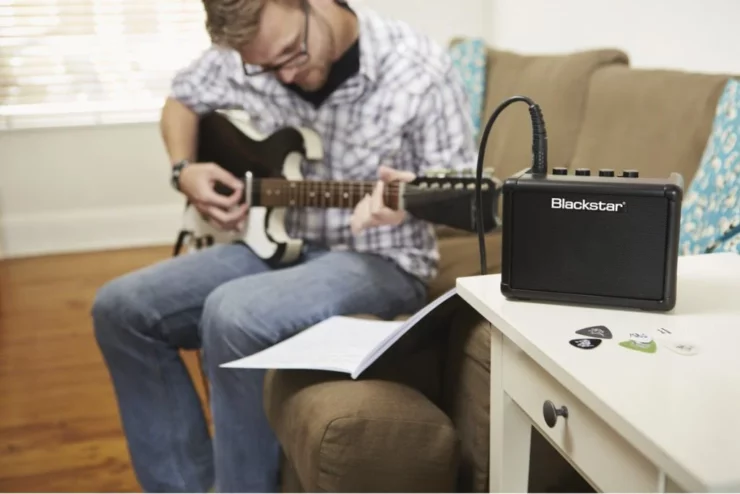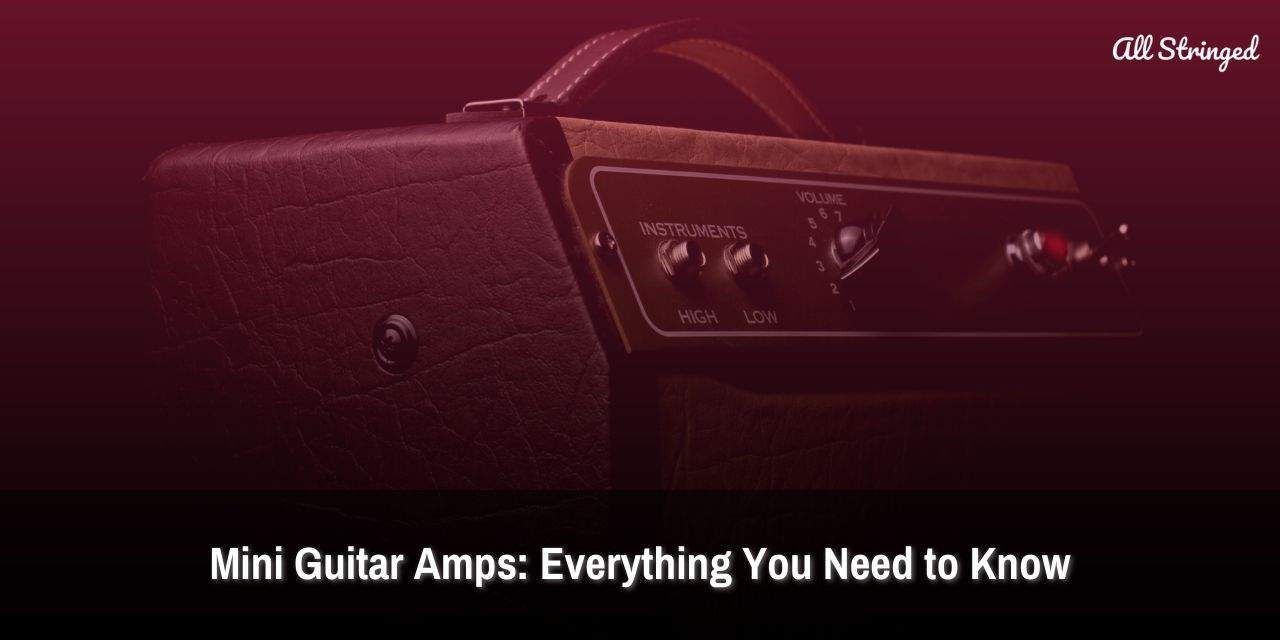If you’re a guitar player, you know how important it is to have the perfect amp for your sound. But what if you don’t have the space or budget for a full-size amp? Mini guitar amps are the perfect solution! In this article, we’ll tell you everything you need to know to choose and use the perfect mini amp for you. So, if you’re ready to kick your sound up a notch, keep reading!
What is a mini guitar amp?
The guitar amp is an electronic device that converts the electric signal into sound. Keyboards, guitars, and other musical instruments tend to generate electric signals. A regular amp can be massive and heavy. Mini guitar amps are a more reasonable alternative, as they amplify your guitar’s sound without needing to lug around a large guitar amp. They are small and light, which makes them the perfect option for musicians on the go or for people who don’t have access to a large guitar amp.

A mini guitar amp is essentially a small, lightweight battery-powered amplifier that is designed to be portable. Mini amps offer everything that you need for playing your guitar and often come with a built-in tuner and effects. Many mini amps have pegs for attaching a guitar strap or a pocket clip so that they can be carried hands-free. It means that you’ll be able to walk around playing your electric guitar, no matter where you are.
>>> Click here to read our review about the Top 15 Best Mini Guitar Amps <<<
A mini guitar amp will allow you to play your instrument without the requirement of a PA system or an external amp. This makes them an ideal option for practicing around the house, at school, or whenever and wherever you get the chance to play. It will be the smaller version of an amp that can be used for practicing anywhere. It makes sense that beginners or musicians with limited budgets would prefer using them, as they are affordable compared to large amps.
Benefits of a mini guitar amp
Practicing with a mini guitar amp will be a great way of kick-starting your career as a guitarist or musician. Further, it is also a wonderful alternative to play live on stage without needing to turn to a large, full-sized amp. Here are some of the primary benefits of a mini guitar amp.
#1. Portability
Guitar amps often have a bad rap when talking about carrying them around. Largely, this is down to the fact that they are quite heavy and can be challenging to carry. However, a mini guitar amp can help make life much easier in this aspect. Not only are they great for practicing, but you can even carry them for a small gig.
You can easily keep a mini guitar amp in your pocket or bag and take it anywhere. There is simply no reason to not bring your own mini amp with you to practice. Further, it’ll also be easier than having to lug around a big, heavy guitar amp.
#2. A great option for practicing
A mini guitar amp can be a wonderful option for any beginner guitarist. You can use it for practicing at home or when you’re on the go. Some of them are highly portable, which means you’ll be able to take them with you on the road or on vacations.
It can be helpful if you don’t want to disturb others by playing your guitar at night. Moreover, many mini amps come with a built-in tuner, which makes it very easy to keep your guitar in tune.
#3. Quality effects
With mini guitar amps, you no longer have to lug around pedals as all the essentials will be included. From reverb to delay, chorus to phaser, to tremolo, and more, Mini amps are fully featured and have everything you need. Some mini guitar amps even come with an app for controlling various effects to give your guitar the sound and effects of your favorite song or guitarist.
>>> Click here to read more about Guitar Amps <<<
Different types of mini guitar amps
Over the past few years, mini guitar amps have become more and more popular among musicians, especially the ones who have been looking for portable and easily affordable options. Despite their miniature size, mini guitar amps are capable of delivering loud sounds and offer features that make them ideal for practicing alone, recording in a band, or performing in small venues. Here are the different types of mini guitar amps available on the market –
#1. Solid-state mini amps
Solid-state mini guitar amps use transistors instead of tubes to amplify the signal, which makes them more affordable and portable. They are generally lighter in weight and have a smaller footprint, making them ideal for practicing at home or on the go. Solid-state mini amps usually come with built-in effects such as distortion, reverb, chorus, and delay, which can be controlled using a simple interface.
#2. Tube mini amps
Tube mini guitar amps use vacuum tubes to amplify the signal, which gives them a warmer and more natural sound compared to solid-state amps. They are more expensive and heavier than solid-state amps but are preferred by guitarists who prioritize tone over portability. Tube mini amps usually come with fewer built-in effects than solid-state amps but offer a better platform for pedals.
#3. Digital modeling mini amps
Digital modeling mini guitar amps use digital technology to simulate the sound of different amps and effects. They can replicate the tones of classic amps such as Fender, Marshall, and Vox and offer a range of effects such as reverb, delay, and modulation. Digital modeling mini amps are ideal for guitarists who want to experiment with different sounds and styles, and are usually affordable and portable.

How to choose a mini guitar amp
If you’re in the market for a new mini guitar amp, then there are certain things that you’ll need to consider. Knowing the right way to choose your new mini guitar amp will put you in an ideal position to find the best amp for your need.
#1. Power rating
You must consider the power output of your mini guitar amp. It is an important factor that you must remember when choosing a new amp.
Wattage is a term used for referring to the amount of power your amp can produce. Higher wattage amps tend to be louder and more powerful. However, this will normally come at the cost of battery life and portability.
A lower-wattage amp might be more suitable if you are looking for an amp for practice or small gigs. Meanwhile, if you want an amp for outdoor performances or larger venues, a higher-wattage amplifier will be a necessity. Mini guitar amps come in a wide variety of wattages, which range from less than 1W to more than 20W. The higher the wattage, the louder will be the amps and the more power it’ll consume.
#2. Size and weight
Next, you’ll need to think of the size and portability factor of the guitar amp. Mini guitar amps are quite compatible and easy to transport. Some models will be smaller than others. If you intend to take your amp on the road or for gigs, you might want to look for an amp that is lightweight and relatively easy to carry. The Boss Katana and the Fly 3 by Blackstar are extremely lightweight, and you can easily carry them around and use them whenever and wherever you want.
#3. Tone and sound quality
You need to evaluate the tone and sound quality of the mini guitar amp. This is one of the most important factors when choosing a mini guitar amp. Look for a mini amp with a clean and clear sound that can accurately produce the tone of the guitar.
#4. Controls and features
You should also examine the controls and features of your amp. Does it have any built-in effects like chorus or reverb? Are you able to adjust the EQ settings to fine-tune the amp? Some mini guitar amps come with built-in drum tracks or metronomes, which can be quite useful for practicing.
#5. Type of music you’ll be playing
It is important that you should consider the type of music you will be playing. Different genres and playing styles will require different features from a mini amp. For instance, if you’re playing hard rock or heavy metal, you’ll require an amp that has a lot of distortion and gain. Meanwhile, if you are going to play acoustic music, you might prefer an amp with a built-in mic or EQ. For instance, the Boss Katana can come in with an inbuilt 3-band EQ.
#6. Type of amp
There are three different types of mini guitar amps – modeling, solid-state, and tube mini guitar amps.
The first one is a modeling mini guitar amp, which makes use of digital technology for simulating the sound of different types of amps and effects. This way, it will offer a wide range of tones in a small package. Next up there are solid-state mini guitar amps, which use transistors for amplifying the signal. These amps are capable of providing a clean, consistent tone. They are typically more affordable compared to tube amps.
The third type is the tube mini guitar amp. It makes use of vacuum tubes for amplifying the signal, producing a natural and warm tone that guitarists favor. However, they are more expensive and need more maintenance than solid-state amps. Each type comes with its unique characteristics and advantages, which allows the players the opportunity to find one that best suits their needs.
#7. Effects
Effects are a key part of any musician’s sound, and mini guitar amps offer various effects in a portable, compact package. The common effects found in mini guitar amps include distortion, reverb, overdrive, chorus, delay, and tremolo.
Some mini guitar amps offer more advanced effects like pitch shifting and modulation. Many mini guitar amps come with built-in effects, whereas others will allow external pedals to be connected. Moreover, some mini amps also offer adjustable EQ controls for fine-tuning the tone to a player’s preference. Effects can enhance the musician’s sound and creativity greatly, while they’ll also provide a convenient and versatile platform for experimenting with different effects.
How to use a mini guitar amp?
Setting up a mini amp
Setting up a mini guitar amp can be quite a simple and straightforward process. However, there are a few things to keep in mind to make sure you’re getting the best possible sound from your instruments. Once you know the right way to set up a mini guitar amp, you’ll be on your way to getting premium tones.
Step 1: Choose the location to play comfortably
The first step to setting up your mini amp will be to choose the perfect location where you can play the guitar comfortably. It can either be a bedroom, a garage, a small studio, or even outdoors. You’ll want to ensure that you’ve got enough space to move around and that you don’t end up disturbing others.
Step 2: Plug in the power
Once you’ve chosen the right location, the next step would be to plug in the power. Most mini guitar amps feature a power adapter, which you can easily plug into a standard electrical outlet. You should ensure that the voltage of the adapter is matching the voltage in your area to avoid damaging the amp.
Step 3: Connect your guitar
The next step would be to connect your guitar to the mini guitar amp. Most mini guitar amps feature a ¼-inch input jack, which you can easily plug your guitar cable into. You should ensure that the cable is plugged into both the guitar and the amp securely so that you can avoid unwanted interference or noise.
Step 4: Adjust the tone and volume
Once you’ve connected your guitar, you can begin to adjust the volume and tone of the mini guitar amp. Most mini amps come with simple controls like volume, tone, and gain. You can start off by turning the volume all the way down and gradually increasing it until you reach a comfortable listening level. You can then adjust the tone so that it suits your preferences and the style of music you are playing.
Step 5: Experiment with different effects
Mini guitar amps come with built-in effects like reverb, distortion, and chorus. You can experiment with these effects and find out the ones that work best for you. Some mini amps come with presets that you can use as the starting point for the tone.
Step 6: Fine-tune the sound
Once you’ve set up the basic sound, you’ll be able to fine-tune it to get the best tone possible. You can experiment with different settings, move the guitar around the room, and listen to how the amp responds. You might even want to try using different kinds of cables, pickups, and guitars to see how they affect the sound.

Using a mini amp for practice
Using a mini guitar amp for practice can be a great way of improving your playing skills and developing your tone. Mini guitar amps are versatile and portable, which makes them an ideal option for guitarists who love practicing at home, on the go, or performing live in small venues. Here are a few tips that will help you practice better using a mini amp –
#1. Make use of headphones
One of the biggest benefits of using a mini guitar amp will be that you can plug in headphones and practice your guitar without disturbing others. This will be especially useful if you share a house with other people or live in an apartment. Most mini guitar amps come with a headphone jack that you can use for connecting your headphones to the amp directly.
#2. Practice with a metronome
Practicing with a metronome is important as it helps develop your timing and accuracy. Most mini guitar amps come with a built-in metronome that you can use for practicing different rhythms and tempos. You can even download metronome apps on your computer and phone and connect them to your amp.
#3. Experiment with different settings
Mini guitar amps come with a wide range of controls that you can use for adjusting your tone and sound. You can also experiment with different settings and find the ones that work best for the type of music you play and your playing style. You can also adjust the gain, tone, volume, and effects for creating different sounds and styles.
#4. Play along with the backing tracks
Playing along with backing tracks will be a great way of improving your timing and developing your sense of rhythm. Further, you can even find backing tracks online or create your own using a DAW or a loop pedal. Plug in your mini guitar amp into your phone or computer and play with the backing track using speakers or headphones.
Using a mini amp for recording
Using a mini guitar amp for recording can be a great way of capturing the tone and sound without having to arrange for expensive studio equipment. Mini guitar amps are easy to use, portable, and affordable, which makes them an ideal option for guitarists looking to record on the go or at home. Here is how you can use mini guitar amps for recording music.
#1. Choose the right mini guitar amp for recording
The first step would be to find the appropriate mini guitar amp for recording. Mini guitar amps come in different styles, sizes, and shapes, with each one of them having its unique tone and sound. Choose an amp that perfectly suits your playing style and the type of music you’ll be recording. Prefer using amps that come with built-in effects that you can use for creating different sounds and textures.
#2. Position the microphone
The position of your microphone will be important for capturing the right sound and tone. Place the mic close to your amp’s speaker and remember it should point directly at the center of the cone. Experiment with different positions to find the one that perfectly captures the sound you desire.
#3. Adjust the tone and volume
Before you start recording, adjust the tone and volume of your mini amp to get the right sound. Start off by turning the volume down and gradually increasing it until you reach the right recording level. Adjust the tone controls to suit the type of music you’ll be recording. Use headphones for monitoring your sound and ensure that the recording level isn’t too high, which can result in distortion.
#4. Record multiple takes
To get the best possible recording, you must record multiple takes. This will give you more options that you can choose from, while it’ll also help you identify areas for improvement. Listen to each recording carefully and choose the one that has captured the best performance.
FAQs
What are mini guitar amps?
Mini guitar amps are small, portable amplifiers designed for practice and performance. They are typically more affordable, lightweight, and compact than regular guitar amplifiers. Mini amps are designed to provide a great tone at lower volume levels and typically include features such as headphone jacks for silent practice.
What should I consider when choosing a mini guitar amp?
When choosing a mini amp, you should consider your budget, size and portability needs, available features, sound quality, and power. It’s important to find the right balance of these factors to ensure you get an amp that meets your needs and provides a great playing experience.
What are some of the benefits of using a mini guitar amp?
Mini guitar amps offer several benefits, including their affordability, portability, and versatility. They are also great for practice, as they typically come with features such as headphone jacks and lower volume levels. Mini amps are also a great choice for small performance spaces, as they can provide a great sound without taking up too much space.



